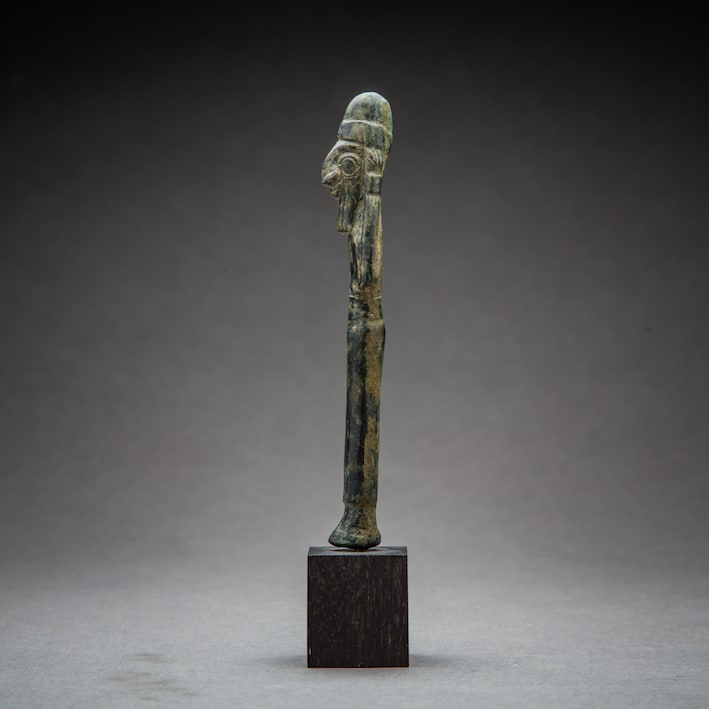Luristan Bronze Figure of a Deity or Priest, 900 BCE - 600 BCE
Bronze
11.4 x 2.5 cm
4 1/2 x 1 in
4 1/2 x 1 in
LK.098
Further images
This handsome figure represents a deity, and pertains to the golden age of Luristan metalworking – around 900-600 B.C. Luristan (or Lorestan) literally means “Land of the Lurs”, and was...
This handsome figure represents a deity, and pertains to the golden age of Luristan metalworking – around 900-600 B.C.
Luristan (or Lorestan) literally means “Land of the Lurs”, and was situated in a wide sweep of the Zagros mountains in what is now western Iran. The sociopolitics of this area are complex, with repeated waves and invasions of Medes, Cimmerians and Persians, amongst others, but the culture thus created is remarkable for its superb control of metalworking. There are many styles, but the best-known pieces of bronze from this area are anthropomorphic and zoomorphic pieces reflecting religious and secular tastes, as well as weaponry and utilitarian items that were buried with the deceased in tombs across the Zagros area. It was nonetheless viewed as a precious resource, and was used alongside iron once this metal became available, for while its qualities of hardness and durability were recognised, it merely made bronze a more socially exclusive material. As these societies are non-literate, explaining the significance of their artistic oeuvres is fraught with difficulty. However, the pose of the figure has much in common with representations of gods and priests in numerous Middle Eastern and Central Asian cultures.
This is particularly reflected in the staid monolithic and linear format of the body and legs, although the arms – raised in power or perhaps supplication – are unusual. The extravagantly bearded (in the trisectorial format) and severely tunic-clad detailing, belted at the waist and surmounted with domed headwear, provides an image of a powerful of authority, not lessened by the slightly gauche smile that he is wearing. The detailing of the face and smaller points – such as the bracelets, which are in themselves evidence of considerable social status – is exquisite. This figure is almost certain to represent some deified individual (such as a priest) or perhaps the deity himself. It is a striking and well-composed piece of ancient art.
Luristan (or Lorestan) literally means “Land of the Lurs”, and was situated in a wide sweep of the Zagros mountains in what is now western Iran. The sociopolitics of this area are complex, with repeated waves and invasions of Medes, Cimmerians and Persians, amongst others, but the culture thus created is remarkable for its superb control of metalworking. There are many styles, but the best-known pieces of bronze from this area are anthropomorphic and zoomorphic pieces reflecting religious and secular tastes, as well as weaponry and utilitarian items that were buried with the deceased in tombs across the Zagros area. It was nonetheless viewed as a precious resource, and was used alongside iron once this metal became available, for while its qualities of hardness and durability were recognised, it merely made bronze a more socially exclusive material. As these societies are non-literate, explaining the significance of their artistic oeuvres is fraught with difficulty. However, the pose of the figure has much in common with representations of gods and priests in numerous Middle Eastern and Central Asian cultures.
This is particularly reflected in the staid monolithic and linear format of the body and legs, although the arms – raised in power or perhaps supplication – are unusual. The extravagantly bearded (in the trisectorial format) and severely tunic-clad detailing, belted at the waist and surmounted with domed headwear, provides an image of a powerful of authority, not lessened by the slightly gauche smile that he is wearing. The detailing of the face and smaller points – such as the bracelets, which are in themselves evidence of considerable social status – is exquisite. This figure is almost certain to represent some deified individual (such as a priest) or perhaps the deity himself. It is a striking and well-composed piece of ancient art.





